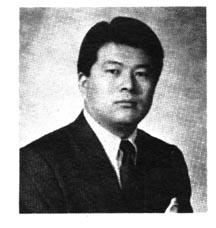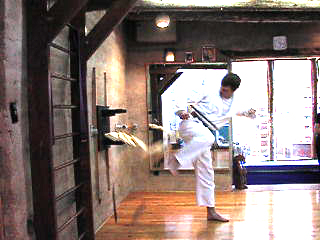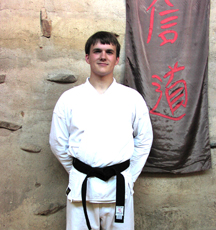[This web page last updated 6 October 2007.]
Ja Shin Do History
Calligraphy by Ja Shin Do founder Jayne West
In 1968, Jayne West, Abby Rockefeller,
and Dana Densmore began training in the Korean martial art of
Tae Kwon Do with Dong Pil Kim, a student at the New England Conservatory
of Music, where Abby was on the faculty.
 | ||
Mr. Kim, a singer and highly skilled black belt martial artist, was running a small martial arts school to support himself and his family while he was at the Conservatory. What he did with his body to generate power was very unusual. Although he called his art "Tae Kwon Do" and described the movements as they had been described to him when he had been a student of Tae Kwon Do himself, what his body was actually doing was very different. This difference was lost on most students, who, both because it was a path of least resistance and because of the verbal instructions being given, developed into a classic Tae Kwon Do style.
But Jayne West had an amazing eye and brilliant visual and analytic mind. Over the months she noticed and with increasing refinement analyzed what Mr. Kim was actually doing. Instead of the circular lines he was describing, he was using straight lines. And, not described at all because unconscious, he was using a highly focused and powerful whole-body action which West named "the shake."
She shared her discoveries with Mr. Kim, and told him that he had the true "scientific method of Tae Kwon Do".
From the beginning of their training, which coincided with the beginning of the second wave of the women's movement, the three taught women's self defense classes and workshops. By 1971 West and Densmore were ready (and feeling the need) to start an independent women's school. Regrettably, this step led to estrangement from Mr. Kim, who felt the loss of his star student keenly. Abby Rockefeller was no longer training, but other women who had joined Mr. Kim's school as part of women's self defense classes they had been teaching moved over to the independent women's school, and dozens more flocked to be part of this.
West and Densmore not only used "the scientific method of Tae Kwon Do" as West had analyzed it, and as she and Densmore continued to refine it, but they developed the pedagogy for efficiency and mastery, with a view to an art that would be powerful and effective for women, for whom self defense was not sport or macho posturing, but a matter of life and death.| Dana Densmore |
This was in contrast to the pedagogy of a typical martial arts school (including Mr. Kim's). In these schools very little instruction was given for the details of how a technique went (leaning heavily on "do like this" and demonstration, sometimes by instructors whose English was rudimentary, other times by Americans who had learned that way from their teachers). And all students were taught together in one large class, all doing all techniques from basics to advanced, with beginners stumbling clumsily through the more advanced techniques--sometimes suffering injury, usually suffering confusion and frustration. To handle a class of mixed levels this way was much less demanding for the instructor, but led to sloppy techniques becoming bad habits even in those who stayed on to gradually refine them.
| Jayne West executing high roundhouse kick
(with Abby Rockefeller blocking) |
Jayne West liked to say that "martial arts are for the weak, not the strong." The strong have many resources. It is those who have not been taught from childhood to express themselves through energetic active physical activity, to assert and defend themselves physically, and to fight when necessary, such as women, who need martial arts training to develop those qualities and skills. Most martial arts schools rewarded those who were already strong and physically confident. They learned quickly, got hurt less, and enjoyed the classes more. Those who were weaker, more timid, less developed in terms of physical coordination and body awareness, and less comfortable with physical clashes, tended not to enjoy the classes and to get hurt and to feel frustrated and sometimes even humiliated. They didn't progress well, and most quickly dropped out. At Mr. Kim's and most other martial arts schools this included most of the women who came. Equally problematic, West and Densmore thought, were schools where women were condescended to, treated with gallantry, not required to meet the same standards as men, sometimes not required to spar with men or do push-ups. Here their inferiority was taken so for granted that they were given a watered-down imitation training that again didn't address the toughening and confidence-building women needed.
In 1974, in recognition of the differences in what they were doing, Jayne West and Dana Densmore formally launched "Ja Shin Do" as a feminist martial art. The Korean words mean the Way of Self Belief. The Chinese characters (selected by West, who was at that time a graduate student in East Asian studies at Harvard ) could also be interpreted as "The Art of the New Self", "The Way of the Determined Spirit", or "The Path of the Fierce Will."
| Dana Densmore executing twin knifehand blocks |
At this point Dana Densmore moved to Washington DC to open the second Ja Shin Do school, assisted by Joan Chernock. With two active Ja Shin Do schools (and often waiting lists of students), excitement was high.
Channel Five WCVB, one of the major Boston commercial television stations, produced a half hour documentary entitled "Dana: Training, Teaching, Living" that included her explaining what the martial art means in her life, how she arranged her own training, how she thought about teaching and moving through the world, with footage of her doing all these things. Two different versions of this program were aired in January 1975. The Washington feminist newspaper off our backs did an article on Densmore and Ja Shin Do as a feminist martial art which also appeared in January 1975. Articles about Ja Shin Do appeared in the journals Country Women and Womanspirit in the summer of 1975.
It was a time when a whole movement of women's martial arts and self defense programs were emerging. In July 1975, Nancy Lehmann, founder of Meechee Dojo, a women's school in Minneapolis, sponsored the first North American (and probably the first in the world) conference for women teaching women's martial arts and self defense. Dana Densmore and Joan Chernock were there, along with a handful of others from around the country. The group was small, but the women knew they were the start of something big, or at least they meant to make it so.Dana Densmore, along with Ja Shin Do students Michele Zavos and Joan Chernock, and with the support of Nancy Lehmann and her school, launched the magazine Black Belt Woman in September 1975 and produced six issues over the next year, plus a directory of women's martial arts schools and classes.
| Knife Block with Back Hook Kick: Dana Densmore and Joan Chernock |
The DC School sponsored the second Intercontinental Conference of Teachers of Women's Martial Arts and Self Defense in January 1976. This four-day conference, held in Washington DC and publicized in the first three issues of Black Belt Woman, drew some fifty participants from the United States and Canada.
In August of 1976, the first Special Training for Women was held in Minneapolis, sponsored by Meechee Dojo and Black Belt Woman and arranged by Nancy Lehmann and her students. This began a tradition which still continues, now sponsored by the National Women's Martial Arts Federation.
After Dana Densmore left Boston to start the DC School (and to work with Donna Allen at the Women's Institute for Freedom of the Press), Jayne West continued teaching on her own every night. But no partner emerged from her other students to give her the pleasure of a shared mission she had enjoyed with Densmore, she began to look for new ways to keep up her own interest. She started working out with some male friends and by early 1975 had begun holding some joint classes at her school with her students and students from Andy Bauman's Tae Kwon Do school.
Andy Bauman had been a fellow student with West and Densmore at Mr. Kim's, and had also gotten his black belt from Mr. Kim. Now he had his own school, as West did, and joint classes with the men gave West a way to maintain her training and also for her women students to test themselves against larger and more aggressive sparring partners.
Joan Chernock got her Ja Shin Do black belt in 1976 and assumed primary responsibility for the DC school. Densmore returned to Boston.
| Joan Chernock and Dana Densmore |
Jayne West's school by then had become largely a mixed school, with only one weekly woman-only class (taught by Densmore), and with Andy Bauman's school increasingly merging into hers. But the demand for an independent women's school in Boston still existed, and after some delay, Densmore filled it by opening another independent women's school in September 1976.
Shortly after that Jayne West apparently became dissatisfied with the joint venture with Bauman's school, or perhaps she had run the course of what she had been wanting to get out of that. She closed her school, retiring not only from teaching, but also from practicing martial arts, to pursue other activities and other physical challenges. She gave the original Ja Shin Do banner, as well as the mirrors, barres, bricks, and other equipment, to Densmore. As the recipient of the original banner, and the remaining founder of the art, Dana Densmore became the lineage holder and director of instruction for all Ja Shin Do schools.
After teaching for a year at the new storefront studio, Densmore launched Artemis Institute to place the Ja Shin Do training in a context of self empowerment, and moved the operation to a studio in her home. She taught from here for the next five years, running classes and workshops and special training involving students from the DC School. And she continued to develop the analysis and pedagogy of Ja Shin Do begun by Jayne West at Mr. Kim's school.
In 1979 Dana Densmore, Joan Chernock, Martha Allen (now an advanced Ja Shin Do student helping run the DC School), and other high ranking students from both the Boston and DC Schools, made an exploratory trip around the country searching for the right place to establish an Artemis Institute Retreat Center, where students could come into residence for intensive training and teacher training. When the group discovered Santa Fe they knew they had found a new home.
In 1982 Densmore and Chernock moved to Santa Fe and construction was begun on the Retreat Center. A Santa Fe school was started. Martha Allen and Mary Danyluk received their Ja Shin Do black belts.
|
|
| Donna Allen fighting the Blue Maxx. |
In 1987, Densmore took a seven-year break to teach in the Great Books program at St. John's College, and discontinued regular classes. During these years she taught privately and semi-privately only. Regular classes resumed again in 1994.
| Krishnan Venkatesh |
In the last year in Boston, Densmore experimented with accepting some men both as Ja Shin Do students and in the Artemis self empowerment program. The Santa Fe school always accepted men (selected with the same care with which women students were selected).
In 1998 Krishnan Venkatesh became the first man to be awarded a Ja Shin Do black belt.
Meanwhile, Martha Allen (now a 3rd degree Ja Shin Do black belt) guided the DC school, teaching in the "closed-door"
style which was established when Artemis Institute was launched,
and which has been followed in Santa Fe. Students join the school
by invitation of the teacher.
Special Training 1998; students and teachers
from DC and Santa Fe Ja Shin Do schools.
 |
In 2004, Bill Davis joined the ranks of Ja Shin Do Black Belts.
Bill Davis breaking four boards with short side kick. |
 |
 |
Under the auspices of Artemis Institute, the martial art is part of a full curriculum of self empowerment and the Full Moon Rising™ program of spiritual warriorship. This curriculum has included retreats, Back Country Adventures, rock-climbing, film discussion classes, and various programs of self empowerment classes, workshops, and intensives. Training in other martial arts has been incorporated, including in particular Filipino stick fighting skills and Brazilian Jiu Jitsu grappling skills. Classes and private instruction continue in Santa Fe. Of particular interest and focus at present, besides the martial art of Ja Shin Do, are: • training in the system The Five Lines of Self Defense,™ an 18-hour course, and • classes in Awareness Energetics,™ a system of mind-body integration, an on-going process that includes Instructor Training.
[Information provided by Dana Densmore]
|
Return to Ja Shin Do main page.
Link to Black Belt Woman magazine page.
Link to Artemis Institute school home page.